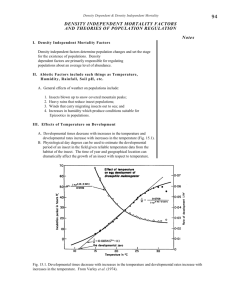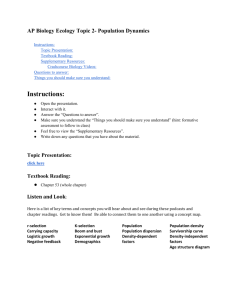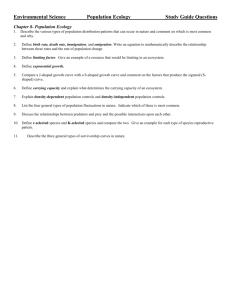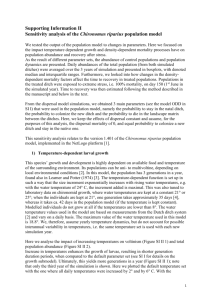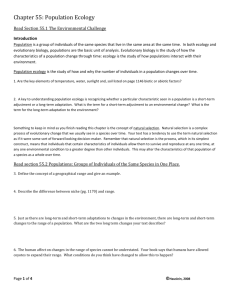Population Dynamics - UC Agriculture and Natural Resources
advertisement
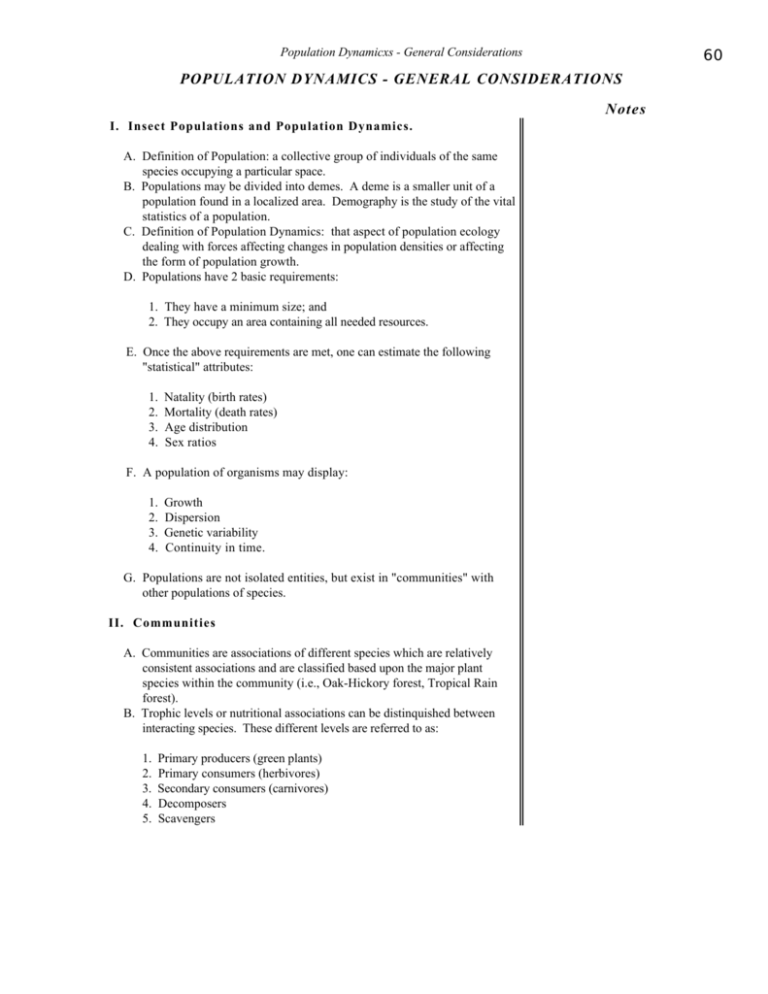
60 Population Dynamicxs - General Considerations POPULATION DYNAMICS - GENERAL CONSIDERATIONS Notes I. Insect Populations and Population Dynamics. A. Definition of Population: a collective group of individuals of the same species occupying a particular space. B. Populations may be divided into demes. A deme is a smaller unit of a population found in a localized area. Demography is the study of the vital statistics of a population. C. Definition of Population Dynamics: that aspect of population ecology dealing with forces affecting changes in population densities or affecting the form of population growth. D. Populations have 2 basic requirements: 1. They have a minimum size; and 2. They occupy an area containing all needed resources. E. Once the above requirements are met, one can estimate the following "statistical" attributes: 1. 2. 3. 4. Natality (birth rates) Mortality (death rates) Age distribution Sex ratios F. A population of organisms may display: 1. 2. 3. 4. Growth Dispersion Genetic variability Continuity in time. G. Populations are not isolated entities, but exist in "communities" with other populations of species. II. Communities A. Communities are associations of different species which are relatively consistent associations and are classified based upon the major plant species within the community (i.e., Oak-Hickory forest, Tropical Rain forest). B. Trophic levels or nutritional associations can be distinquished between interacting species. These different levels are referred to as: 1. 2. 3. 4. 5. Primary producers (green plants) Primary consumers (herbivores) Secondary consumers (carnivores) Decomposers Scavengers 61 Population Dynamicxs - General Considerations Notes C. Definite food chains can be distinquished in the community. Branching food chains make up food webs. 1. Food chain: a trophic path or succession of populations through which energy flows in an ecosystem as a result of consumerconsumed relationships. 2. Food web: a complex of branching, joining, or diverging food chains that connect together the various populations in an ecosystem. D. Communities exist within "ecosystems". Fig. 9.1. The trophic relationships of alfalfa, pests and their natural enemies. Figure from van den Bosch et al. 1982. Notes III. Ecosystems A. An "ecosystem" is an interacting, self-sustaining, natural system of living organisms (the community) and of a chemical-physical component (the abiotic environment). This is the basic functional unit in ecology. 62 Population Dynamicxs - General Considerations Notes B. In biological control we deal with "agroecosystems" which are ecosystems composed of cultivated land, the plants contained or grown thereon, and the animals associated with these plants. These are extremely limited systems and they can be very unstable. C. Within ecosystems, populations are thought to exist in a state of "homeostasis". This idea was suggested by Herbert Spencer (1897). Homeostasis is the tendency of a system to maintain a dynamic equilibrium, and if disturbed, to restore that equilibrium. The more complex a biological system (community) the more stable it usually is to disturbances. The more complicated the system the more reliable is the system of checks and balances against rise and fall. IV. Arthropod Pest Populations Within Agroecosystems. A. In agroecosystems one strives to maintain arthropod pests at noneconomic levels (not a "pest free" situation). B. Economic Injury Level: the level at which insect induced damage can no longer be tolerated and therefore the level at or before which it is desirable to initiate deliberate control activities. C. Economic Threshold: the pest density at which control measures should be applied to prevent an increasing pest population from reaching the economic injury level. D. Economic threshold may also be referred to as the "action threshold", "density treatment level" or "treatment threshold". These terms usually do not include the influence of market values on the system and mainly refer to the impact of the pest upon the plant's productivity. E. Most insects are maintained at very low population levels by "natural control" and are not viewed as pest species. Only 10,000 to 30,000 of the one million insect species known are pests. These pests feed on crops, forests, pasture lands, or livestock or menance our health, comfort or possessions. F. Natural control is the maintenance of a more or less fluctuating population density within certain definable upper and lower limits over a period of time by the combined actions of the whole environment. V. Population Growth and Regulation A. Population ecology was originally confined to demography of human populations as was practiced by Chinese and Egyptian census takers. B. Malthus (1803) published "Essay on the Principles of Population" which considered overpopulation of mankind. His ideas were similar to those of Giovanni Botero (1588) who proposed the same concept of population regulation. C. Malthus' idea was that "Man" increases at a geometric rate but his food supply does not. Soon became known as the "Malthusian Principle". Malthus was criticized because "Man" was considered to be capable of controlling his own birthrate. Another problem was that he considered the increase in subsistence (food & housing) was in a arithmetic ratio which was a major error. If this was so populations would increase without limit. 63 Population Dynamicxs - General Considerations Notes D. Charles Darwin (1859) accepted Malthus' principle. He placed much stress on: 1. Biotic mortality factors in the environment; 2. Competition as a major regulation factor; and 3. Climate as a factor in limiting population growth. E. Herbert Spencer (1897) emphasized the concept of stability of the heterogeneous state and the instability of the homogeneous state. F. Harry Scott Smith (1929) argued that the introduction of a complex of natural enemies (rather than a single species) should be employed in classical BC programs. He emphasized that the different kinds of natural enemies available vary as to the particular habitats where they excel and that the biological control to be expected from their combined actions, as conditions vary from place to place and time to time, would be greater than that to be expected from the action of any one of them alone. QUESTIONS 1. 2. 3. 4. What statistical attributes can be estimated from an insect population? What is the relationship between communities and ecosystems? Define both entities. Why are agroecosystems "unstable" compared to natural ecosystems? What is the importance of an economic threshold on a crop with respect to biological control? DEFINITIONS OF POPULATION ECOLOGY TERMS Abiotic mortality factors: Non-living environmental factors that bring about premature death of plants and animals. Agroecosystem: The ecosystem composed of cultivated land, the plants contained or grown thereon, and the animals associated with these plants. Area of discovery: A variable equal to the width of track along which a female parasite searches multiplied by the length of the track accumulated while searching through the parasite's lifetime. Fluctuates with parasite density due to "interference". Abbreviated "a". Biotic mortality factors: Living environmental factors that bring about premature death of plants and animals. Carrying capacity: The density level at which the rate of increase of a species population is zero which is equivalent to the equilibrium population density. Abbreviated "K". Competitive exclusion principle: If two species are similar enough to each other in their requirements (or niches), then one will go to extinction due to competition in the areas where their population distributions overlap. Also known as Gause's Principle, Grinnell's Axiom, Volterra-Gause Principle, and Competitive Displacement Principle. Conditioning forces: Environmental factors or agents which, uninfluenced by density, contribute to the setting or fixing of a framework of potential environmental capacity or affect interim population realization when capacity is not attained. Deme: A smaller unit of a population found in a localized area. Population Dynamicxs - General Considerations Delayed density-dependent mortality: Mortality inflicted on the members of a population, the magnitude of which is determined by the density of the population at some time in the past. Density-dependent mortality = Facultative mortality: Mortality inflicted on the members of a population, the degree of which is related to or affected by the density of the population. Density-independent mortality = Catastrophic mortality: Mortality inflicted on the members of a population, the degree of which is unrelated to or unaffected by the density of the population. Direct density-dependent mortality: Mortality inflicted on the members of a population, the magnitude of which increases as the current density of the population increases and which decreases promptly as the current density of the population declines. Economic injury level: The pest population density level at which insect induced damage can no longer be tolerated and therefore the level at or before which it is desirable to initiate deliberate control activities. Abbreviated "EIL". Economic threshold: The pest population density at which control measures should be applied to prevent an increasing pest population from reaching the economic injury level. Abbreviated "ET". Ecological homologues: A species which has the same niche as another species. The two species do not have to be related genetically. Ecosystem: An interacting, self-sustaining, natural system consisting of living organisms (the community) and of a chemical-physical component; the basic functional unit in ecology. Environmental capacity: The level of population for a species which an environment can sustain without pernament change. Exponential growth: The tendency for populations to grow in numbers according to a geometric progression. Food chain: A trophic path or succession of populations through which energy flows in an ecosystem as a result of consumer/consumed relationships. Food web: A complex of branching, joining, or diverging food chains that connect together the various populations in an ecosystem. Functional response: The changes in the number of attacks per parasite (or predator) upon the host as the host (or prey) density changes. Inversely density-dependent. Genetic feedback: Theory of population regulation based on the continued genetic change of a host and its parasite through time. Governing mechanism: The actions of repressive environmental factors, collectively or singly, which intensify as the population density increases and relax as this density falls (= density-dependent action). Handling time: The time interval that elapses from the first encounter of a host (or prey) by a natural enemy until the instant when the natural enemy resumes its search. Homeostasis: The tendency of a system to maintain a dynamic equilibrium and, if disturbed, to restore that equilibrium. Also termed population equilibrium or population balance. Hypervolume model of niche: Technique used to describe niche of a species using several variables such as temperature, humidity, food preferences, etc. 64 Population Dynamicxs - General Considerations Interference: A form of intraspecific competition between individual natural enemies at high natural enemy densities. Refers to interruptions in searching experienced by chance meetings of parasites. Intrinsic rate of increase: The fraction by which a population increases in size per unit of time. Abbreviated "r". Inverse density-dependent mortality: Mortality inflicted on the members of a population, the magnitude of which decreases as the current density of the population increases and which increases as the current density of the population decreases. Killing value: Percentage mortality due to some agent expressed in logarithms to the base 10. Abbreviated "K" factor. Logistic growth: The combination of the tendency for populations of organisms to grow in numbers according to a geometric progression, and the tendency for the environment to inhibit the attainment of excessively high densities by such growing populations. Natural control: The maintenance of a more or less fluctuating population density within certain definable upper and lower limits over a period of time by the combined actions of the whole environment. Niche: The place or position, in both a physical and a functional sense, of a species population in an ecosystem as determined by the full complex of environmental factors impinging on and limiting the population. Nicholsonian parasite: A parasite which produces mortality in its host in a delayed density-dependent manner. Nonreciprocal density-dependent mortality: Mortality inflicted on a population by a biotic mortality factor whose own numbers are not changed as a consequence. Numerical response: The increase in parasites or predators as a result of the increase in their host or prey, respectively. Population: A collective group of individuals of the same species occupying a particular space. Quest constant: The value of the "area of discovery" when the natural enemy density is equal to one individual per unit area (i.e., 1 parasite per cm2). Reciprocal density-dependent mortality: Mortality inflicted on a population by a biotic mortality factor whose own numbers are changed as a consequence. Steady state: Condition in which parasite and its host coexist in a state of equilibrium. Volterra's principle: If two species (predator/prey, parasite/host) are destroyed at the same rate by some outside agency (such as a pesticide application), the prey will proportionately increase and the predators will proportionately decrease. REFERENCES Huffaker, C. B., H. T. Gordon & R. L. Rabb. 1984. Meaning of ecological entomology - the ecosystem. p. 3–17. In Ecological Entomology (C. B. Huffaker and R. L. Rabb, editors). John Wiley and Sons, New York. 844 pp. Huffaker, C. B. & P. S. Messenger. 1964. Population ecology - historical development. p. 45–73. In Biological Control of Insect Pests and Weeds (P. DeBach, editor). Chapman and Hall Ltd., London. 844 pp. 65 Population Dynamicxs - General Considerations Huffaker, C. B. & P. S. Messenger. 1964. The concept and significance of natural control. p. 74–117. In Biological Control of Insect Pests and Weeds (P. DeBach, editor). Chapman and Hall Ltd., London. 844 pp. Huffaker, C. B., P. S. Messenger & Paul DeBach. 1971. The natural enemy component in natural control and the theory of biological control. p. 16–67. In Biological Control (C. B. Huffaker, editor). Plenum Publ. Corp., N. Y. 511pp. Huffaker, C. B., F. J. Simmonds &J. E. Laing. 1976. The theoretical and empirical basis of biological control. p. 41–78. In Theory and Practice of Biological Control (C. B. Huffaker and P. S. Messenger, editors). Academic Press, N. Y. 788 pp. Luckmann, W. H. & R. L. Metcalf. 1975. The pest-management concept. p. 3–35. In Introduction to Insect Pest Management (R. L. Metcalf and W. H. Luckmann, editors). John Wiley & Sons, N. Y. 587 pp. P i a n k a , E . R . 1 9 7 4 . Evolutionary ecology. Harper & Row, Publ., N. Y. 356 pp. P r i c e , P . W . 1 9 7 5 . Insect Ecology. John Wiley & Sons, N. Y. 514 pp. Thompson, J. N. 1984. Insect diversity and the trophic structure of communities. p. 591–606. In Ecological Entomology (C. B. Huffaker and R. L. Rabb, editors). John Wiley and Sons, New York. 844 pp. Van Driesche, R. G. and T. S. Bellows, Jr. 1996. Biological control. Chapman and Hall, New York. 539 pp. Varley, G. C., G. R. Gradwell & M. P. Hassell. 1974. Insect population ecology - an analytical approach. Univ. Calif. Press, Berkeley and Los Angeles. 212 pp. van den Bosch, R., P. S. Messenger & A. P. Gutierrez. 1982. An introduction to biological control. Plenum Press, N. Y. 247 pp. READING ASSIGNMENT: Chapter 18: pp. 367–398, Van Driesche, R. G. and T. S. Bellows, Jr. 1996. Biological control. Chapman and Hall, New York. 539 pp. 66
